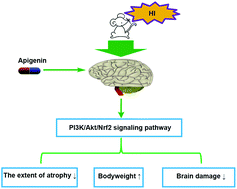Neuroprotective effect of apigenin against hypoxic-ischemic brain injury in neonatal rats via activation of the PI3K/Akt/Nrf2 signaling pathway
Abstract
Neonatal hypoxic-ischemic (HI) brain injury can lead to mortality and severe long-term disabilities including cerebral palsy and brain injury. However, the treatment options for neonatal hypoxic-ischemic (HI) brain injury are limited. Apigenin is abundantly present in vegetables, celery, and chamomile tea with diverse biological functions, such as anti-inflammatory, anti-apoptotic, antioxidant, and anticancer effects. However, it has not yet been reported whether apigenin exerts a neuroprotective effect against neonatal hypoxic-ischemic (HI) brain injury. In this study, we investigated whether apigenin could ameliorate HI brain injury and explored the associated mechanism using in vivo experiments. We found that apigenin remarkably reduced the infarct volume and ameliorated cerebral edema, decreased inflammatory response, inhibited apoptosis, promoted the recovery of tissue structure, and improved prognosis following HI brain injury. Mechanistically, we found that apigenin exerted a neuroprotective effect against HI brain injury by activating the PI3K/Akt/Nrf2 pathway. In summary, all these results demonstrate that apigenin could be a potential therapeutic approach for neonatal hypoxic-ischemic (HI) brain injury.



 Please wait while we load your content...
Please wait while we load your content...